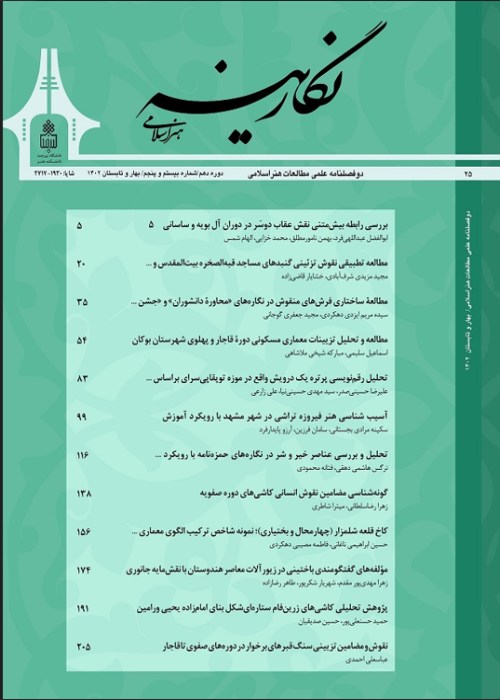A statement on the main parts of women’s clothing in Andaruni of Qajar court (From the era of Fath-Ali Shah to the end of the Naseri era)
Author(s):
Article Type:
Research/Original Article (دارای رتبه معتبر)
Abstract:
Women’s clothing during the Qajar era was frequently cited in historiographical sources, such as the travelogues of foreign tourists, and portrayed in paintings and photographs. This article addresses the following question: What are the main parts of women’s clothing in the Qajar court (From the era of Fath-Ali Shah to the end of the Naseri era and prior to the popularity of European clothes), and how are their qualitative characteristics compared? From the time of Fath-Ali Shah until the end of Naser al-Din Shah’s reign, this article examines the form, texture, color, design, and pattern of main and frequently worn parts of women’s clothing in the Qajar court, especially during the reign of Fath-Ali Shah. The objective of this developmental research and the analytical-historical study was attained by utilizing probability sampling and qualitatively reviewing documentary studies, text reading, and image reading. Results indicated that women’s clothing in the Qajar court mainly consisted of shirts, Arkhalig, and Kolija. All social classes wore shirts, but their fabrics varied, with silk fabrics being more acceptable at the court level. Arkhalig is a short gown worn over a shirt with short and long sleeves as well as sleeves with triangle/samosa lace; its later type with a more decorative appearance was known as Chigen. The economic status of the wearer determined which types of simple fabrics, Mahrams, and motifs (tartan) would be used in the sewing of arkhalig. During the reign of Naser al-Din Shah, the kolija grew in popularity, and although it was deemed more appropriate for the winter season, it was evidently worn throughout the year. This mantle is up to the middle of the thigh and typically has sleeves that reach the elbow. Kolija is very similar to the men’s kind; like the men’s kind, it was a special dress of the affluent. Plain and expensive fabrics such as velvet or motifs (tartan), particularly cashmere, were frequently used in sewing kolija.
Keywords:
Language:
Persian
Published:
Journal of Negarineh Islamic Art, Volume:9 Issue: 24, 2023
Pages:
179 to 194
magiran.com/p2688054
دانلود و مطالعه متن این مقاله با یکی از روشهای زیر امکان پذیر است:
اشتراک شخصی
با عضویت و پرداخت آنلاین حق اشتراک یکساله به مبلغ 1,390,000ريال میتوانید 70 عنوان مطلب دانلود کنید!
اشتراک سازمانی
به کتابخانه دانشگاه یا محل کار خود پیشنهاد کنید تا اشتراک سازمانی این پایگاه را برای دسترسی نامحدود همه کاربران به متن مطالب تهیه نمایند!
توجه!
- حق عضویت دریافتی صرف حمایت از نشریات عضو و نگهداری، تکمیل و توسعه مگیران میشود.
- پرداخت حق اشتراک و دانلود مقالات اجازه بازنشر آن در سایر رسانههای چاپی و دیجیتال را به کاربر نمیدهد.
In order to view content subscription is required
Personal subscription
Subscribe magiran.com for 70 € euros via PayPal and download 70 articles during a year.
Organization subscription
Please contact us to subscribe your university or library for unlimited access!




